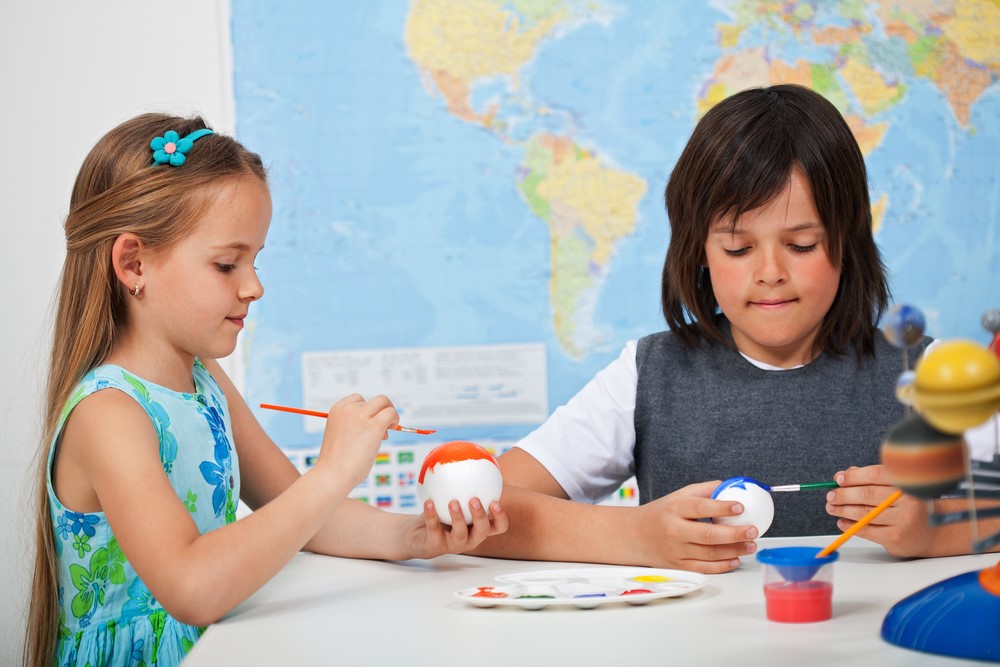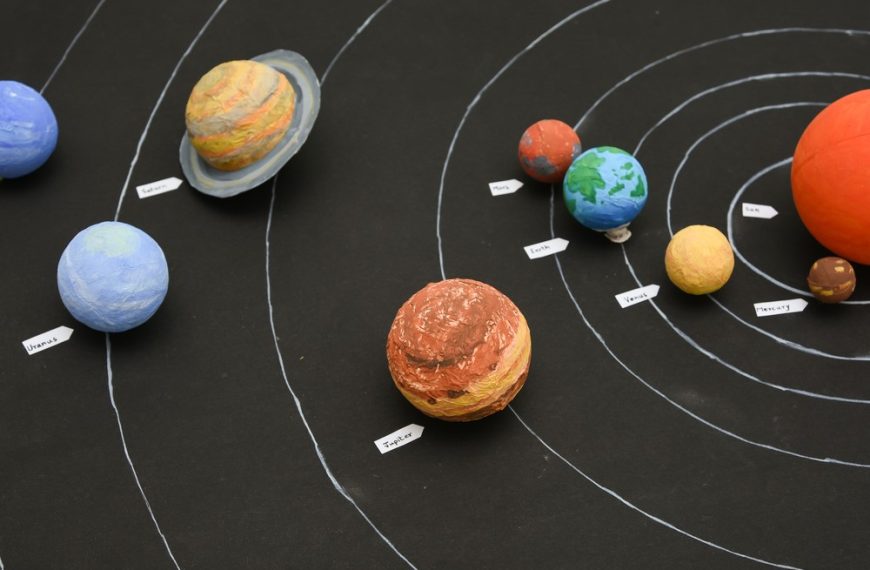Earth is where we dwell and where life exists. The Earth is part of this vast universe which is constantly evolving and moving around. The universe contains all astronomical or celestial things. The solar system consists of celestial bodies that are gravitationally bound and orbit around the Sun.
The Sun, the nearest star to Earth, is located at the centre of the solar system surrounded by eight planets Mercury, Venus, Earth, Mars, Jupiter, Saturn, Uranus, and Neptune. Every planet has unique qualities and characteristics. The solar system includes the Sun, planets, asteroids, satellites, and orbits. It is elementary to understand the planets and the Sun, which comprise the solar system.
Before we move on with this article, be sure you understand the order of the planets in the solar system. It is necessary to understand the order of the planets to determine which planets should be put apart from each other. It is also crucial to understand the size and colour of each planet so that the project works can be done easily.
Engaging Solar System Projects for Kids

Fostering a comprehension of difficult scientific topics is sometimes tricky in the field of education. But when these ideas are conveyed in a fun and practical way, learning is made not just simpler but also incredibly pleasurable. Our solar system is one such subject of curiosity that has captured the interest of generations. A science project for kids may be a great way to introduce young minds to the mysteries of space. This blog will explore inspiring solar system project ideas, go through step-by-step instructions for making a science project for kids, and highlight the supplies needed to start on this educational trip.
Unveiling The Solar System Project For Kids
Children’s exposure to the solar system is like opening the door to a fascinating cosmos. Children can understand each celestial body’s size, arrangement, and properties via hands-on projects, sparking a lifetime interest in science and space exploration. An engaging solar system project piques their interest and motivates students to go outside the textbook. A solar system activity for children is the ideal technique to teach them about the alignment of the planets and stars. The beauty of the universe and its boundless potential fascinate us.
The Solar System, which contains many other planets, includes the Earth, the planet we call home. Kids’ solar system science projects aid in their understanding of the sun as well as the planets that orbit it. These solar system science activities and projects for kids aid their understanding and education of their world.
Upper elementary schools teach students about the solar system. To assist students in grasping the subject, teachers frequently encourage students to create simple solar system projects for kids. Some materials may be used to create solar system models. Here are some fantastic suggestions for kids’ solar system science projects.
The Cosmic Challenge: Solar System Project Ideas For Schools
Kids get the chance to develop their creativity while learning about the planets and their distinctive characteristics by making a solar system project. Here are some inspiring solar system project ideas for schools that can captivate kids’ brains as well as teach them:
- Model Making Extravaganza:
- Edible Solar System:
- Planet Fact Cards:
- Orrery Construction:
Building a physical model of the solar system is a tried-and-true but efficient method of instructing children about the positioning of the planets and their orbits. To precisely depict each planet, you may choose from a variety of materials like foam sheets or styrofoam balls. Don’t forget to paint them in hues corresponding to the planets’ true appearance. As they put the planets in the correct placements, students may use this activity as a terrific approach to help them comprehend the idea of scale.
Why not turn learning into a reward? Ingenious ways to engage youngsters in learning include making an edible solar system. To represent the planets, use various-sized fruits, such as oranges, grapes, and blueberries. You may mimic the alignment of the solar system by placing these fruits on wooden skewers in a precise pattern. They learn about the arrangement of the planets while also getting hands-on experience building their small universe.
You can combine creativity with study by creating planet fact cards. Give each youngster a planet, and instruct them to learn about their given heavenly body. Then, using art tools, they may make aesthetically appealing fact cards. Through discussing and presenting their results, individuals will learn not only more about the planet they were given but also about the entire solar system.
Building a basic orrery might be an interesting project for a more complex one. An orrery is a mechanical model that depicts how heavenly bodies move about one another. Children may create an orrery that faithfully depicts the planets’ orbits around the sun using straightforward items like paper, cardboard, and toothpicks. Thanks to this research, the study of our solar system now includes a physics and engineering component.
Crafting The Cosmos: Space Exploration Project
Getting youngsters started on a space exploration project trip requires a methodical strategy combining teaching and creativity. Here is a step-by-step tutorial for creating an engaging space exploration project for kids:
- Step 1: Research and Learning
- Step 2: Material Selection
- Step 3: Design and Planning
- Step 4: Hands-On Creation
- Step 5: Learning through Presentation
Before starting the project, introduce the fundamental elements of the solar system, such as the sun, planets, moons, and other celestial bodies. Outline the position of the planets about the sun and briefly discuss their special qualities. Age-appropriate literature, internet sources, and films can all be used to communicate this knowledge successfully.
The material selection greatly influences the success of the project. Collect resources like styrofoam balls, foam sheets, wooden skewers, paints, painting tools, cardboard, toothpicks, and a variety of fruits, depending on the project concept you’ve chosen.
Support the children as they create their solar system project. Help them choose each planet’s size and the orbits’ configuration if they are making a model. Encourage children to come up with inventive methods to display their knowledge for projects like the edible solar system or planet fact cards.
The magic takes place here. Help the youngsters paint and assemble their culinary arrangements or solar system models. They will discover the characteristics, dimensions, and positions of each planet throughout this period.
Encourage the children to show their work to their friends, parents, or teachers after the projects are finished. This action increases their self-assurance and solidifies their comprehension of the parts of the solar system and how they relate to one another.
Essential Solar System Project Materials
A project using the solar system must have the right ingredients to succeed. Depending on the project you choose, you’ll need a range of supplies to make the universe come to life. The necessary solar system project supplies for numerous project ideas are listed below:
- For Model Making:
- Styrofoam balls (assorted sizes)
- Foam sheets
- Paints (acrylic or poster paints)
- Paintbrushes
- Wooden dowels or skewers
- Craft glue
- For Edible Solar System:
- Oranges
- Grapes (different colours)
- Blueberries
- Wooden skewers
- Toothpicks (for attaching fruit)
- Cutting board and knife (for preparing fruit)
- For Planet Fact Cards:
- Coloured construction paper or cardstock
- Markers or coloured pencils
- Reference books or online sources
- Glue or double-sided tape
- For Orrery Construction:
- Cardboard or heavy paper
- Brass fasteners or paper fasteners
- Markers or coloured pencils
- Small beads (to represent planets)
- Toothpicks or wire (for connecting planets to the central axis)
It’s rewarding to include kids in the marvels of science through practical projects. A solar system project fosters children’s creativity, critical thinking, and curiosity while also teaching them about the celestial bodies that make up our universe. You may go on a voyage of discovery with young minds by following the instructions in this article and using the appropriate resources, inspiring a lifetime of enthusiasm for exploration and knowledge.
Kids may better understand the vastness of the universe and each planet’s distinctiveness by incorporating the cosmos’ beauty into a practical endeavour. The solar system project ideas covered here offer a rich educational experience that combines learning with creativity, whether it is making a model, creating fact cards, creating an edible arrangement, or building an orrery. So gather your supplies, spark your creativity, and embark on a cosmic trip that will stay in young people’s imaginations for years to come.
The cosmos is within us, as Carl Sagan memorably remarked. Star material makes up who we are. We are a means through which the cosmos learns about itself. Through these solar system initiatives, we not only educate children about the cosmos but also foster in them a lifelong appreciation for its beauty.
For informative and accurate articles on all things related to your new born-toddler’s development, growth, health and nutrition, follow EuroKids Blogs and do check out our nationally recognized preschools – EuroKids for the first step in your kid’s educational journey!

















